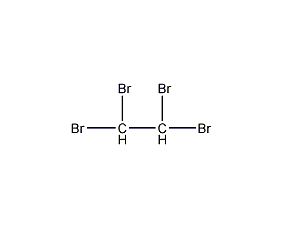
Structural formula
| Business number | 01PL |
|---|---|
| Molecular formula | C2H2Br4 |
| Molecular weight | 345.65 |
| label |
Added flame retardants, catalyst, initiator, refrigerant, Extinguishing agent, fumigation disinfectant, reagents for microscopy, Flotation agent; aliphatic halogenated derivatives |
Numbering system
CAS number:79-27-6
MDL number:MFCD00000133
EINECS number:201-191-5
RTECS number:KI8225000
BRN number:1098321
PubChem number:24888766
Physical property data
1. Properties: yellow liquid with camphor and chloroform odor. [1]
2. Melting point (℃): 0[2]
3. Boiling point (℃): 243.5 [3]
4. Relative density (water = 1): 2.96[4]
5. Relative density (Air=1): 11.9[5]
6. Saturated vapor pressure (kPa): 2.00 (119℃)[6]
7. Critical pressure (MPa): 4.6[7]
8. Octanol/water partition coefficient: 2.55[8]
9. Flash point (℃): 160[9]
10. Ignition temperature (℃): 335[10]
11. Solubility: Insoluble in water, soluble in most organic solvents such as ethanol and chloroform. [11]
12. Viscosity (mPa·s, 19.19ºC): 9.80
13. Heat of evaporation (KJ/kg): 133.97
14. Heat of fusion (KJ/kg): 33.78
15. Specific heat capacity (KJ/(kg·K), 16.1~99.02ºC, constant pressure): 0.513
Toxicological data
1. Acute toxicity[12]
LD50: 1200mg/kg (rat oral); 5250mg/kg (rat oral) Skin)
LC50: 549mg/m3 (rat inhalation, 4h)
2. Irritation[13]
Rabbit transdermal: 500mg (24h), moderate irritation.
Rabbit eye: 100mg, mild irritation.
3. Subacute and chronic toxicity [14] In the chronic toxicity test, the liver weight of various animals increased, and there were pathological changes in the liver and kidneys.
Ecological data
1. Ecotoxicity[15] LC50: 19mg/L (48h) (medaka)
2. Biodegradation Performance [16] MITI-I test, initial concentration 100ppm, sludge concentration 30ppm, degradation 29% after 2 weeks.
3. Non-biodegradability No information available
Molecular structure data
1. Molar refractive index: 42.15
2. Molar volume (cm3/mol): 115.0
3. Isotonic specific volume (90.2K ): 315.0
4. Surface tension (dyne/cm): 56.2
5. Polarizability (10-24cm3): 16.71
Compute chemical data
1. Reference value for hydrophobic parameter calculation (XlogP): 3.6
2. Number of hydrogen bond donors: 0
3. Number of hydrogen bond acceptors: 0
4. Number of rotatable chemical bonds: 1
5. Number of tautomers: none
6. Topological molecule polar surface area 0
7. Number of heavy atoms: 6
8. Surface charge: 0
9. Complexity: 26.5
10. Number of isotope atoms: 0
11. Determine the number of atomic stereocenters: 0
12. Uncertain number of atomic stereocenters: 0
13. Determine the number of chemical bond stereocenters: 0
14. Number of uncertain chemical bond stereocenters: 0
15. Number of covalent bond units: 1
Properties and stability
It can decompose when exposed to light and heat and turn yellow. Above 190°C, the decomposition product is highly toxic carbonyl bromide vapor. Reacts with strong base to release hydrogen bromide. It is stable at room temperature and will decompose when heated to 239~242°C to release bromine, hydrogen bromide, etc.
Storage method
Storage Precautions[17] Store in a cool, ventilated warehouse. Keep away from fire and heat sources. Keep containers sealed and store them separately from oxidants, alkalis, and food chemicals. Avoid mixed storage. The storage area should be equipped with emergency release equipment and suitable containment materials.
Synthesis method
1. Obtained from the addition of acetylene and bromine. Add bromine into the glass-lined reaction pot and add a small amount of water to seal the bromine liquid level. Then slowly introduce acetylene gas from the bottom of the liquid and keep it at 58-62°C and 0.02-0.05MPa for aeration reaction for 5-7 hours. Stop the reaction when the reaction liquid gradually turns yellow. Wash the reaction solution with dilute sodium carbonate solution, then wash with water until neutral, separate the washing water, and obtain the finished product of tetrabromoethane. Raw material consumption quota: bromine 1110kg/t, calcium carbide 1940kg/t.
2. Directly pass the purified acetylene into the reactor that has been previously filled with bromine and water, control the pressure to 1.9613~4.9033KPa, and carry out the reaction at a reaction temperature of <50°C, and then use dilute alkali After washing with liquid, the upper layer of alkali liquid is removed, and then washed with water to obtain the finished product.

Purpose
1. This product is used as an intermediate for quaternary ammonium compounds, medicines, and dyes. It is used as an additive flame retardant. It is also used as an intermediate for the synthesis of quaternary ammonium compounds, medicines, and dyes. It is also used for the preparation of chemical fibers. Cocatalyst, initiator of polyester oxidation process, refrigerant, fire extinguishing agent and fumigation disinfectant, etc. Used as reagents for microscopy, flotation agents and solvents.
2. Used for mineral processing and as solvent. [18]

 微信扫一扫打赏
微信扫一扫打赏

